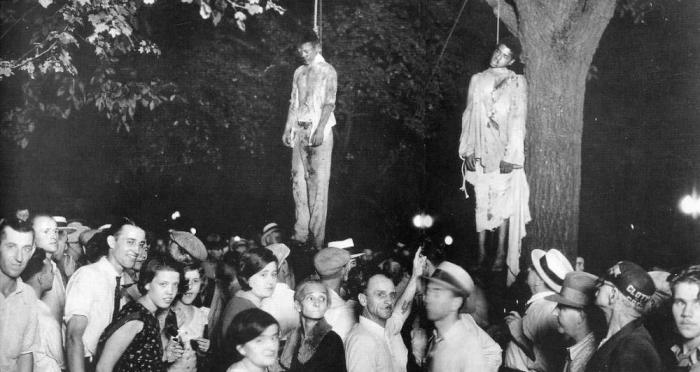On August 7, 1930, a mob of White people, using crowbars and hammers to break into the Grant County jail in Marion, Indiana, dragged 19-year-old Thomas Shipp (1912–1930) into the street, where they beat, stabbed, tortured, and hanged him, along with 19-year-old Abram Smith. A third young man, 16-year-old James Cameron survived the beating.
Earlier that afternoon, the three young Black men had been arrested, accused of murdering a White man and assaulting a White woman. As word of their arrest spread in the community, a mob of angry White residents grew, gathering outside the jail. By 10:30 that evening, after the two older young men had been dragged from their jail cells, the mob had grown to a size between five and ten thousand [some sources say ten to fifteen thousand] people. Spectators watched and cheered as the mob lynched the men, ultimately hanging them from a tree in the courthouse yard. They brutally murdered Thomas and Abram, without a trial and without proof of their guilt.
As their bodies remained hanging above the crowd, some of the mob re-entered the jail and dragged out James. They beat him severely, but, as they were preparing to hang him alongside Thomas and Abram, someone in the crowd stopped them, saying the teenager was innocent. Members of the mob then released James.
The battered bodies of Thomas and Abram remained hanging from the courtyard trees for several hours as a growing crowd of White men, women, and children participated in the spectacle until the sheriff cut the ropes off the corpses, at which time the crowd rushed forward, taking parts of the men's bodies as souvenirs.
The NAACP, enraged by the lynchings, traveled to Marion to investigate the crimes of the mob. They later provided to the State Attorney General the names of 27 people who were believed to have participated. Photographs clearly showing the lynching and the spectators were used to identify the murderers, but local residents said they did not recognize anyone in the photos. Charges eventually were brought against the leaders of the mob, but, in each trial, an all-White jury acquitted each man, despite solid cases and overwhelming evidence. The Black teenager James, however, was tried for murder and was convicted of being an accessory. He served four years in prison.
After his release, James founded four NAACP chapters in Indiana, wrote hundreds of essays on civil rights, and authored a 1982 memoir. On June 19th (Juneteenth) of 1988, he opened America’s Black Holocaust Museum in Milwaukee, Wisconsin, which documents the African-American Struggle. “I can forgive but I can never forget,” he said. “That’s why I started this museum.” In 1991, the state of Indiana pardoned James. He died in 2006.
The photograph included here shows the corpses of Thomas and Abram hanging lifeless from a tree, while White spectators appear to be enjoying the spectacle. This photo remains one of the most iconic and infamous photographs of an American lynching. In 1937, when schoolteacher Abe Meeropol saw the photo, he was inspired to write “Strange Fruit,” a haunting poem about lynching (see below). That poem later became a famous song recorded by Billie Holiday.
Strange Fruit
by Abe Meeropol
Southern trees bear a strange fruit,
Blood on the leaves and blood at the root,
Black body swinging in the Southern breeze,
Strange fruit hanging from the poplar trees.
Pastoral scene of the gallant South,
The bulging eyes and the twisted mouth,
Scent of magnolia sweet and fresh,
And the sudden smell of burning flesh!
Here is a fruit for the crows to pluck,
For the rain to gather, for the wind to suck,
For the sun to rot, for a tree to drop,
Here is a strange and bitter crop.
A sad ending to this tragedy: Years later, the alleged assault victim, Mary Ball, testified that she had not been raped.









